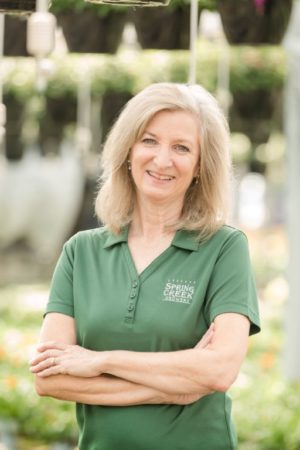Carla Jones, the owner of Spring Creek Growers in Magnolia, Texas, pinpoints what one should look for in a Christmas tree before bringing it home.
By April Cumming, Photos by Sara Jane
It can be frustrating for some and frivolous fun for others. Separated by a mere month’s worth of time, it’s enticingly easy to get carried away with Christmas planning and decorating before the Thanksgiving Day pumpkin pie has been put in the oven.
Newspapers are chock-full of day-after-Thanksgiving Black Friday and Cyber Monday ads, and precut-Christmas-tree racks line home-improvement-store parking lots and roadsides leading to Grandma’s house.
 This year, start a new family tradition—and restore some of your holiday-season sanity—with a visit to a Christmas-tree farm. There are approximately 100 such farms in the state of Texas, says Carla Jones, owner of Spring Creek Growers Christmas-tree farm in Magnolia, Texas. To find one near you, visit texaschristmastrees.com/findafarm.html.
This year, start a new family tradition—and restore some of your holiday-season sanity—with a visit to a Christmas-tree farm. There are approximately 100 such farms in the state of Texas, says Carla Jones, owner of Spring Creek Growers Christmas-tree farm in Magnolia, Texas. To find one near you, visit texaschristmastrees.com/findafarm.html.
Located on a sprawling 20 green acres about 45 minutes northwest of the Houston metropolitan area, Spring Creek Growers is a family-run operation.
“[My grandparents] purchased the property in 1921 from my grandfather’s family, so the property has been in our family for a very long time,” Jones says. “We planted our first Christmas trees around the mid- to late-1980s and sold our first trees in 1992.”
As last year’s president of the Texas Christmas Tree Growers Association, Jones had the honor of delivering three 7-foot trees from Spring Creek Growers to the Texas Capitol last Christmas.
“It was a wonderful experience,” Jones says of the delivery. “We were so pleased that Mrs. Abbott actually greeted us at the steps of the Capitol…We had a great time and she was most gracious accepting the trees.”
This year marks the farms’ 25th growing season, and Jones says she’s eager to open her home to the public Nov. 18. Before you go, be sure to visit springcreekgrowers.com to double-check the farm’s hours.
What to Look for in a Christmas Tree
“Each have their own individual beauty, that’s for sure,” Carla Jones says, “but the No. 1 thing about a fresh tree is going to be its fragrance, and that is the bonus to having a real tree. They all have their own unique qualities, as far as their shape and their branching habits.
“In my family, when you mention ‘artificial tree’—which, my children, that’s all they’ve grown up with is a real tree—they always find it rather amusing. They can’t imagine having the same tree every year. They love the idea of, ‘What’s the tree going to look like this year?’ ”
Here’s what to expect from the trees Jones grows and sells on her farm:
- Virginia pine or plantation pine. These trees feature longer, thin needles and strong branches, and are more fragrant. “They respond to rain and sunshine very well, and we’ve had an abundance of that this year,” Jones says. “This is my personal favorite because it’s the first variety of tree we ever planted at our farm, many years before we added the leyland cypress.”
- Leyland cypress. This hypoallergenic tree has light and fluffy branches, and is less fragrant. “We grow our leyland cypress in a container, for families who like to plant their Christmas trees. So, they can display them for the season in the house and then, once the season’s over, you can go ahead and plant the tree on your property,” Jones explains.
- Frasier fir. These trees are precut and brought to the farm from North Carolina. They are very fragrant, and have strong and sturdy branches.
- Noble fir. These precut trees are brought to the farm from Oregon. They offer more space between branches, which means more room to display larger ornaments.
The Pros and Cons of Buying a Real Christmas Tree
Pros:
Freshness. “They’re the freshest trees you’re going to find in the season because they’re still growing,” Carla Jones is quick to point out.
Selection experience. “It’s a fun, family event,” Joes says. “Some of our customers have been with us all 24 years and they return because it becomes such a family tradition. Their Christmas starts with us.”
Good for the environment. “After the season, there’s all kinds of opportunities for recycling—and not just for mulch,” Jones says. “The trees are also used down at the coast to help prevent beach erosion, so it helps build the dunes back up. They’re also used for fishing habitats, so if we have any leftover trees from the season, we donate them to the fisherman. They make great fish habitats in our lakes.”
Cons:
Budget. Artificial trees are known for their affordability. Expect to spend anywhere between $60 and $100 for an average-sized tree at a farm.
Upkeep. There’s a hard-and-fast rule to abide by when taking care of a real tree. “Never let the level of water drop below the tree trunk,” Jones says. “The tree will feel that, seal itself off and not take up any more water.” Once you get a tree home from a tree farm, Jones advises you place another fresh cut on it—taking about an inch off the trunk—to ensure it will readily soak up water. “In short, treat your fresh-cut tree as you would a fresh-cut flower,” Jones says. “The same principles apply.”


